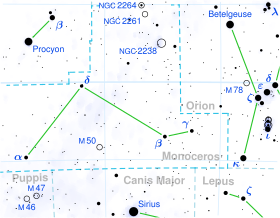 Global Information
Global InformationAlpha Monocerotis information
 | |
| Observation data Epoch J2000.0 Equinox J2000.0 (ICRS) | |
|---|---|
| Constellation | Monoceros |
| Right ascension | 07h 41m 14.832s[1] |
| Declination | −09° 33′ 04.078″[1] |
| Apparent magnitude (V) | 3.94[2] |
| Characteristics | |
| Spectral type | G9.5 III-IIIb Fe-0.5[3] |
| B−V color index | 1.022[2] |
| Astrometry | |
| Radial velocity (Rv) | +10.50[2] km/s |
| Proper motion (μ) | RA: -74.989 mas/yr[1] Dec.: -19.838 mas/yr[1] |
| Parallax (π) | 22.3839 ± 0.1348 mas[1] |
| Distance | 145.7 ± 0.9 ly (44.7 ± 0.3 pc)[1] |
| Absolute magnitude (MV) | 0.71±0.08[4] |
| Details | |
| Mass | 1.78±0.11[5] M☉ |
| Radius | 10.05[5] – 10.42±0.12[6] R☉ |
| Luminosity | 63.7±1.3[6] L☉ |
| Surface gravity (log g) | 2.81±0.08[5] cgs |
| Temperature | 5049±32[6] K |
| Metallicity [Fe/H] | −0.01±0.03[5] dex |
| Rotation | 326 days[7] |
| Rotational velocity (v sin i) | 1.9[7] km/s |
| Age | 1.824±0.283[5] Gyr |
| Other designations | |
α Mon, 26 Monocerotis, BD−09° 2172, HD 61935, HIP 37447, HR 2970, SAO 134986[8] | |
| Database references | |
| SIMBAD | data |
Alpha Monocerotis, Latinised from α Monocerotis, is the Bayer designation for the brightest star in the equatorial constellation of Monoceros. It can be viewed with the naked eye, having an apparent visual magnitude of 3.94.[2] Based upon an annual parallax shift of 22.4 mas as seen from Earth,[1] it is located 146 light-years away from the Sun. The star is moving away from the Sun with a radial velocity of +10.5 km/s.[2]
The stellar classification of G9.5 III-IIIb Fe-0.5[3] indicates this is an evolved giant star of type G, which means the hydrogen has been depleted at its core and the outer envelope has expanded and cooled. The 'Fe−0.5' notation indicates the spectrum displays a slight underabundance of iron relative to other stars of this temperature. It is a red clump giant, which means it is generating energy through helium fusion at its core.[9] At the age of 1.8 billion years, this yellow-hued star has an estimated two times the mass of the Sun and 10 times the Sun's radius.[5] It is spinning sedately with a rotation period of about 326 days.[7]
- ^ a b c d e f Cite error: The named reference
DR3was invoked but never defined (see the help page). - ^ a b c d e Cite error: The named reference
aaa454_3_943was invoked but never defined (see the help page). - ^ a b Cite error: The named reference
perkins1989was invoked but never defined (see the help page). - ^ Cite error: The named reference
aaa458_2_609was invoked but never defined (see the help page). - ^ a b c d e f Cite error: The named reference
Gomes2021was invoked but never defined (see the help page). - ^ a b c Cite error: The named reference
baineswas invoked but never defined (see the help page). - ^ a b c Cite error: The named reference
aaa421_241was invoked but never defined (see the help page). - ^ Cite error: The named reference
SIMBADwas invoked but never defined (see the help page). - ^ Cite error: The named reference
laney2012was invoked but never defined (see the help page).